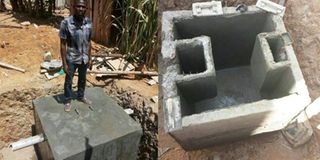Manage your waste with bio-digester

A man stands on top of a finished bio-digester. Photo by Roland D. Nasasira
What you need to know:
Managing waste such as faecal matter is not easy. However, with technology, a new sceptic tank has been developed to ease waste management especially in homes.
All her life, Flavia Amiya, a resident of Kitinda Village, Nkumba parish in Wakiso District had known only two methods of sewerage disposal; the pit latrine and the septic tank. One day as she was contemplating digging a septic tank, she was told about the managing director of Home Contractors, Julius Kirumira, who introduced her to the new method of sewage disposal called a bio-digester.
Reluctantly, after Kirumira had convinced her about the benefits of the bio-digester, she decided to have one installed in her home.
Fits in small spaces
“If you have a small plot of 50 feet by 50 feet, you can build a house and the bio-digester anywhere in the remaining small space of the compound. No one can ever tell that it is in your compound. It economises space and does not take a long time to be constructed,” Amiya explains. The bio-digester that was built at her house serves six other houses, all rental units in one fence.
Similarly, David Kasumba, also a resident of the same place, uses the bio-digester at his home and kindergarten. His kindergarten has approximately 20 nursery pupils and his home about 15 people.
“I weighed the option of the septic tank and the bio-digester with my engineer and chose the latter. It was unbelievable that it only required excavating about three feet deep and occupied about one metre in width and length,” Kasumba explains.
Unlike the ordinary septic tank, materially, Kasumba says the bio-digester is also economical in terms of construction material.
“The builders of the bio-digester only required half a small truck of sand, half a truck of aggregate for concrete and few bags of cement and less labour. The construction and installation process took only four days and the builders came with the material,” Kasumba says, adding that he paid Shs2m which included labour.
Before settling down for the bio-digester, Kasumba says he and his engineer had budgeted for approximately Shs7m to construct the ordinary septic tank and that the construction was to take approximately two weeks.
Ngamba Island Chimpanzee Sanctuary in Lake Victoria also tapped into the new sewage management technology 14 months ago. At the island, the sanctuary maintenance manager, Boniface Ojok, says they use the bio-digester because of the level of environment sensitivity, being in the middle of the lake.
“Before we adopted the bio-digester, we used special sewage collection bags which we would seal to keep them air tight. At times, we sundried the sewage from the guest cottages and used it as manure. Sewage management was basically a challenge until we learned of the bio-digester tank that converts sewage into water and gas,” Ojok says.
Ojok says construction of the bio-digester cost them Shs3m and that it occupied a width and length of one and a half metre. He adds that it serves four to 10 guests that camp at the island. If it was to be built on the mainland, Ojok says it would have cost Shs2.5m. The additional Shs500,000 was for transportation costs of the materials from the mainland at Entebbe to the island, a distance of approximately 25 kilometres on water.
About the bio-digester
Julius Kirumira, the managing director of Home Contractors, says when you flush the toilet, sewage and water is channelled and directed into the bio-digester.
There, the bio-digester uses naturally occurring anaerobic bacteria to treat the sewage by digesting and decomposing it besides eliminating disease causing organisms. After the chemicals contained in the water have been sieved and the sewage decomposed, it is directed to the soak pit that contains rocks and stones, before going into the ground.
The sewage and other organic matter from the toilet then settle at the bottom of the bio-digester and are then converted by bacteria into water and gas ready to dissolve into the ground. “This conversion process starts immediately after flushing. It gets rid of carbondioxide and gases such as methane and this means that the water contains nitrogen that can be used for irrigation. It can also be used domestically when treated further,” Kirumira says.
Joseph Buwembo, an engineer, says unlike the ordinary septic tank, the bio-digester can be installed in areas with high water tables because it doesnt break easily. It does not require emptying.




